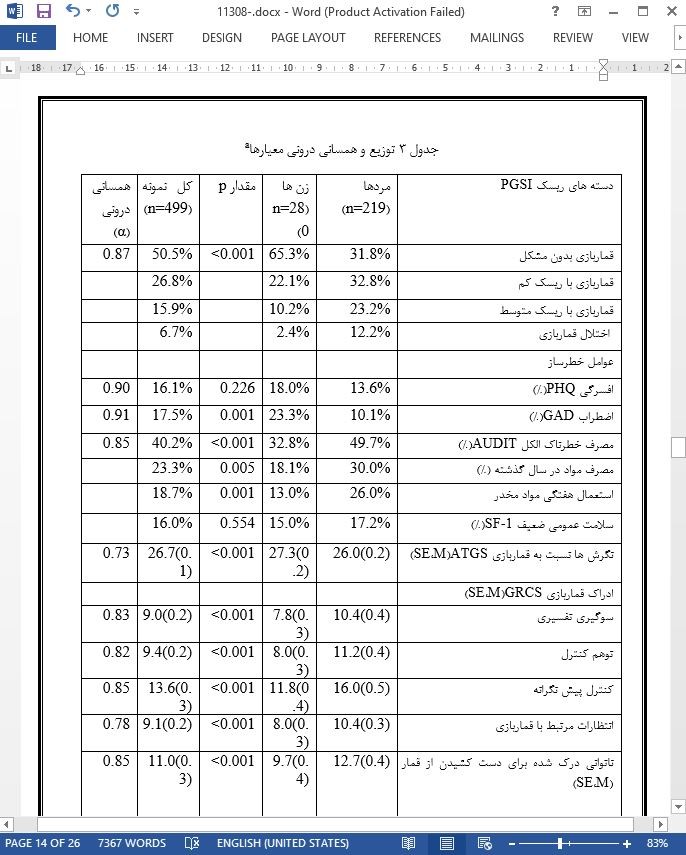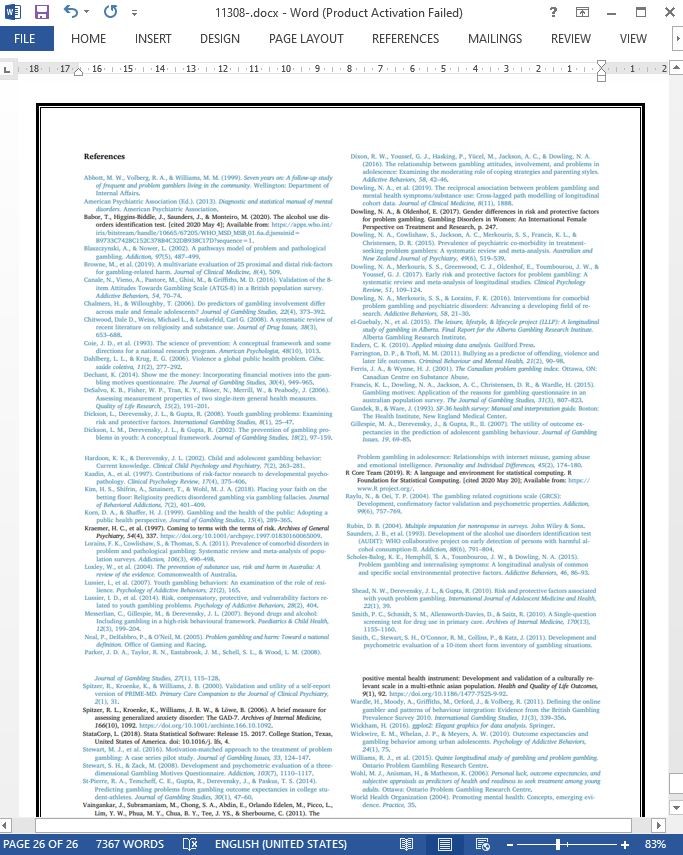
عوامل خطرساز، جبرانی و محافظ در اختلال قماربازی: نقش ویژگی های سلامت روانی مثبت
چکیده
شواهد کمی وجود دارد تا بر اساس آن درباره عوامل جبرانی و محافظ برای اختلال قماربازی نتیجه گیری کنیم. هدف این مطالعه بررسی توانایی بالقوه ویژگی های سلامت روانی مثبت (مقابله کلی، حمایت عاطفی، معنویت، مهارت های میان فردی، رشد شخصی و استقلال و تاثیر جهانی) برای ایفای یک نقش جبران کننده و محافظ در اختلال قماربازی در یک نمونه در دسترس از ۴۹۹ دانشجوی دانشگاه استرالیایی می باشد. استفاده خطرناک از الکل، استفاده از مواد مخدر در سال گذشته، ادراک (شناخت) مبتنی بر قمار ( سوگیری تفسیری، توهم کنترل، کنترل پیش نگرانه، انتظارات مرتبط با قمار بازی، ناتوانی درک شده برای دست کشیدن از قمار)، شرایط پرخطر قماربازی ( شرایط تقویت مثبت و منفی ) و انگیزه های قماربازی( پول، احساسات مثبت، تنظیم وضعیت درونی و چالش ) به طور مثبت، شدت اختلال قماربازی را پیش بینی کرد. هیچ یک از ویژگی های سلامت روانی مثبت، به طور منفی، شدت اختلال قماربازی را پیشبینی نکرد که نشان می دهد این عوامل نقش جبران کننده ایفا نمی کنند. با این وجود، حمایت عاطفی، رشد فردی و استقلال و تاثیر جهانی، تاثیر انگیزه های قماربازی و شرایط پرخطر را میانگیری کردند که نشان می دهد که این عوامل یک نقش محافظ ایفا کردند. در مقابل، معنویت یک رابطه قابل پیش بینی مثبت و مستقیم با شدت اختلال قماربازی نشان داد، که نشان می دهد به عنوان یک عامل خطر ساز در این نمونه نقش ایفا کرد. شناسایی این عوامل خطر ساز تعدیل شونده و محافظ به توسعه موثر اقدامات پیشگیری و مداخله ای(درمانی) کمک می کند. به تحقیقات طولی بیشتری که از نمونه های نماینده جمعیت استفاده می کند، نیاز است تا نتایج این تحقیق را تکرار کند و عوامل خطر محافظ، جبرانی و خطر سازِ مرتبط با توسعه اختلال قماربازی رابطه ای، جمعی و اجتماعی را بررسی کند.
4.5. نتیجه گیری
با وجود این محدودیت ها، این مطالعه بینش های جدید مهمی در رابطه با عوامل محافظ ارائه می کند که بر عوامل خطرساز شناخته شده برای کاهش این تأثیرات تاثیر دارند. به طور خاص، این مطالعه به توانایی حمایت عاطفی، رشد فردی و استقلال و تاثیر جهانی به میانگیری تاثیر انگیزههای قمار بازی و شرایط پرخطر تاکید دارد. این مطالعه به مجموعه شواهد روبه افزایش درباره اینکه استعمال مواد مخدر، ادراک قمار بازی، شرایط پر خطر و انگیزههای قماربازی، نقش خطرساز در توسعه اختلال قماربازی ایفا میکنند، میافزاید. شناسایی این عوامل حمایتی و خطرساز قابل تعدیل به توسعه اقدامات درمانی و پیشگیرانه موثر کمک می کنند. علاوه بر این، به تحقیقات طولی که از نمونه های نماینده جامعه استفاده می کند نیاز است تا این نتایج را تکرار کند و به بررسی عوامل محافظ، جبرانی، خطرساز در سطح رابطه و جامعه بپردازد.
Abstract
There is a limited evidence base from which to draw conclusions about compensatory and protective factors for problem gambling. The aim of this study was to explore the potential for positive mental health characteristics (general coping, emotional support, spirituality, interpersonal skills, personal growth and autonomy, and global affect) to play a compensatory role and protective role in problem gambling in a convenience sample of 499 Australian university students. Hazardous alcohol use, past-year substance use, gambling-related cognitions (interpretive bias, illusion of control, predictive control, gambling-related expectancies, and perceived inability to stop gambling), gambling high-risk situations (negative and positive reinforcement situations), and gambling motives (money, positive feelings, regulate internal state, and challenge) positively predicted problem gambling severity. None of the positive mental health characteristics negatively predicted problem gambling severity, suggesting that these factors did not play a compensatory role. However, emotional support, personal growth and autonomy, and global affect buffered the influence of gambling motives and high-risk situations, suggesting that these factors played a protective role. In contrast, spirituality displayed a direct positive predictive relationship with problem gambling severity, suggesting that it served to act as a risk factor in this sample. The identification of these modifiable risk and protective factors has implications for the development of effective prevention and intervention initiatives. Further longitudinal research employing population-representative samples is required to replicate these results and investigate relationship-, community-, and societal-level risk, compensatory and protective factors associated with the development of problem gambling.
4.5. Conclusion
These limitations notwithstanding, this study provides important new insights regarding the role of protective factors that interact with established risk factors to mitigate their effects. Specifically, it highlights the potential for emotional support, personal growth and autonomy, and global affect to buffer the influence of gambling motives and high-risk situations. It also adds to the growing body of evidence that substance use, gambling cognitions, high-risk situations, and gambling motives play a risk role in the development of problem gambling. The identification of these modifiable risk and protective factors has implications for the development of effective prevention and intervention initiatives. Further longitudinal research employing population-representative samples is required to replicate these results and investigate relationship-, community-, and societal-level risk, compensatory, and protective factors associated with the development of problem gambling.
نکات مهم
چکیده
1. مقدمه
1.1.عوامل خطرساز برای اختلال قماربازی
1.2.عوامل جبران کننده و محافظ برای اختلال قماربازی
1.3. اهداف مطالعه
2. روش
2.1. مشارکت کنندگان
2.2. معیارها
2.3. روش
2.4. تحلیل داده ها
3. نتایج
3.1. آمارهای توصیفی
3.2. عوامل خطرساز برای اختلال قماربازی
3.3نقش جبران کننده (جبرانی) ویژگی های سلامت روانی مثبت
3.4. نقش محافظ ویژگی های سلامت روانی مثبت
4. بحث
4.1. عوامل خطرساز برای اختلال قمار بازی
4.2. عوامل محافظ و جبرانی اختلال قماربازی
4.3. کاربردهای مطالعه
4.4. محدودیت های مطالعه
4.5. نتیجه گیری
ABSTRACT
1. Introduction
1.1. Risk factors for problem gambling
1.2. Compensatory and protective factors for problem gambling
1.3. Study aims
2. Method
2.1. Participants
2.2. Measures
2.3. Procedure
2.4. Data analysis
3. Results
3.1. Descriptive statistics
3.2. Risk factors for problem gambling
3.3. The compensatory role of positive mental health characteristics
3.4. The protective role of positive mental health characteristics
4. Discussion
4.1. Risk factors for problem gambling
4.2. Compensatory and protective factors for problem gambling
4.3. Study implications
4.4. Study limitations
4.5. Conclusion
- اصل مقاله انگلیسی با فرمت ورد (word) با قابلیت ویرایش
- ترجمه فارسی مقاله با فرمت ورد (word) با قابلیت ویرایش، بدون آرم سایت ای ترجمه
- ترجمه فارسی مقاله با فرمت pdf، بدون آرم سایت ای ترجمه



